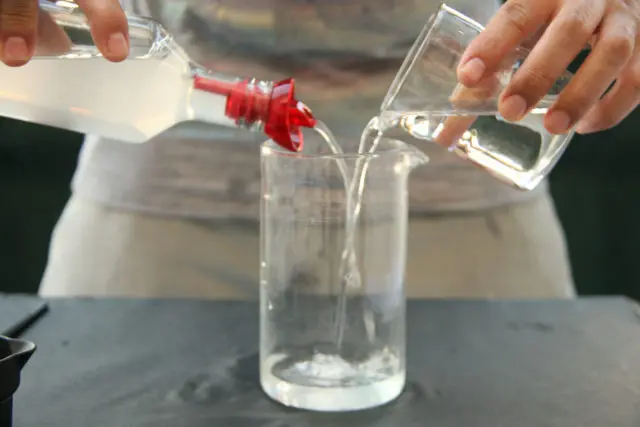Contents
- What kind of soil do blueberries like
- How to acidify soil for blueberries
- Safety measures
- How to acidify blueberry soil with vinegar
- How to acidify the soil for blueberries with citric acid
- Colloidal sulfur for acidifying blueberries
- How to acidify soil for blueberries with electrolyte
- How to acidify the soil under blueberries with oxalic acid
- How to acidify blueberries with sulfur powder
- Other agrotechnical measures to increase the acidity of the soil
- How often to acidify blueberries
- How can I mulch the soil under blueberries
- Conclusion
Garden blueberry is a rather unpretentious plant in terms of care. Thanks to this property, its popularity among gardeners has greatly increased in recent years. However, when growing it, many are faced with the fact that for the normal development of this plant, special land preparation is needed. If you do not acidify the soil for blueberries in a timely manner, then you may not wait for the harvest, and the bushes themselves may die.
What kind of soil do blueberries like
Blueberries grow in many regions of the country, but attempts to grow a wild plant at home have usually ended in failure. But the breeders did not abandon their attempts to “cultivate” this berry, and their work was crowned with success. As a result, garden blueberries were bred – a cultivated variety that grows well and bears fruit abundantly when grown in artificial conditions.

One of the specific features of garden blueberries is their exactingness to the soil. In a garden, it cannot be planted in a place where any cultivated plants have grown before. The soil should be light, breathable, moderately moist, with good drainage. Blueberries will not grow in swampy areas. Another important feature of the soil for this berry is its acidic reaction of about 3,5-4,5 pH. High-moor peat has such a pH level, it is these soils (peat-sandy loam) that are the best for planting blueberries. To improve the properties, rotten leaves, coniferous litter, spruce or pine bark, ground cones are added to it.
Why blueberries need acidic soil
The need for acidic soil is associated with the peculiarity of the structure of the root system of garden blueberries. Unlike ordinary plants, it lacks the finest root hairs, with the help of which nutrients are absorbed from the soil. Their role is played by microscopic soil fungi that form mycorrhiza with blueberry roots. Thanks to them, the plant absorbs water and nutrients. However, such a symbiosis can only exist in an acidic environment; other soil is not suitable for this.
How to make soil for blueberries with your own hands
It is possible to give any soil the properties necessary for the normal growth of blueberries by adding various components. And also it will be necessary to artificially increase the acidity of the soil. The optimal substrate for growing blueberries is a mix of sand, high-moor peat (at least 50% of the total volume), fallen needles and sawdust. It is very good to add a layer of topsoil from under coniferous trees to the composition of the nutrient soil, since it contains a large amount of the necessary fungi.
How to determine that it is necessary to acidify the soil
To determine whether the soil under blueberries needs acidification, the easiest way is by the color of its leaves. With an insufficient level of acidity, they turn red. However, this method should not be used in autumn, because at this time the plant begins to prepare for winter and the red color of the leaves is a natural reaction to a cold snap.
How to determine the acidity of the soil for garden blueberries
Soil acidity can be determined in other ways. Here is some of them.
- pH meter. A specialized electronic device designed to accurately determine the acidity of the soil. It is a probe on an insulated wire, which is stuck into the soil in the desired area. Instrument readings are displayed on an indicator with an arrow scale or digital values.
- Litmus. Kits of litmus test papers can often be found in gardening stores. To determine the acidity, a soil sample is poured with distilled water and stirred well. After the soil particles settle, a litmus test is taken. The level of acidity is determined by the color of the indicator and special tables. Green color indicates an alkaline reaction, if the acidity level is high, the sample turns red.
 Important! Only distilled water can be used, only it has a guaranteed neutral level of acidity and will not affect the accuracy of the measurement.
Important! Only distilled water can be used, only it has a guaranteed neutral level of acidity and will not affect the accuracy of the measurement. - You can roughly estimate the degree of soil acidification by wild plants growing on the site. The presence of common and horse sorrel, plantain, horsetail is a sign of soil acidification.
- It is possible to measure the acidity of the soil if you prepare an infusion of currant or cherry leaves. A few leaves are poured with boiling water and allowed to cool. Then a piece of soil is lowered into a container with infusion. If the infusion turns red, then the soil is strongly acidified, blue indicates weak acidity, green indicates neutral.
- You can determine if the soil is acidic or not by using vinegar. It is enough just to water them in the ground. A violent reaction with the release of foam will indicate alkalization of the soil. Small bubbles are evidence of weak acidity. The absence of any effect indicates that the soil is highly acidified.
- You can find out the reaction of the soil if you dissolve a piece of chalk or lime for whitewashing in a bottle of water, add some soil there and put a rubber ball on the neck. If the soil is acidic, a reaction will begin, accompanied by the release of gas, as a result, the balloon will begin to inflate.
How to acidify soil for blueberries
If the soil for blueberries is not acidic enough, then it can be acidified artificially. This can be done using various organic and inorganic acids, introducing their weak solutions into the root zone.
Safety measures
The preparation of solutions containing acid is a rather dangerous job that requires accuracy and care. Contact with even a small concentration of an acid solution on the skin, in the respiratory system or eyes can lead to the most serious consequences. The use of personal protective equipment (rubber gloves, goggles, mask or respirator) when working with acids and their solutions is strictly mandatory. To prepare solutions for acidification, chemically neutral dishes made of glass or plastic resistant to aggressive media should be used. Metal containers should not be used due to a possible chemical reaction.

How to acidify blueberry soil with vinegar
Acetic acid is food grade and is sold in grocery stores as an essence at a concentration of 70% or a ready-to-use 9% solution. To acidify the soil, it is the second option that is needed. 100 ml of food vinegar (you can also use apple cider vinegar) is diluted in 10 liters of water, after which the soil of the root zone is shed with an area of approximately 1 sq.m. This method of acidification can only be used as a one-time short-term measure. Vinegar kills many beneficial bacteria living in the roots, plant nutrition is disrupted, and yields drop. In addition, vinegar in the ground decomposes rather quickly, so this method, as a rule, is not enough even for 1 garden season.
How to acidify the soil for blueberries with citric acid
Citric acid for blueberries is a more gentle remedy. However, it is not durable either. To acidify the soil for blueberries with citric acid, take 1 g of powder for 10 bucket of water (5 l), dissolve and water the root zone.
Colloidal sulfur for acidifying blueberries
Sulfur must be ground into a fine powder. The average rate of its consumption per 1 sq. m is 15 g. Before using colloidal sulfur for blueberries, the root zone is abundantly watered, then the powder is gently and evenly scattered in a thin layer. Usually this substance is used to acidify the soil in early spring, as well as in autumn, during planting.
How to acidify soil for blueberries with electrolyte
The electrolyte that is poured into acid batteries is a solution of sulfuric acid. It can be used to acidify the soil. To prepare the solution, only 30 ml of electrolyte is needed, it must be diluted in 1 bucket of water (10 l). This is quite enough to process 1 square. m root zone of blueberries.

How to acidify the soil under blueberries with oxalic acid
Oxalic acid is a common ingredient found in many cleaning products. It is effective and quite environmentally friendly. Unfortunately, you can meet it on the shelves of hardware stores less and less. To prepare an acidifying solution, dissolve 5 g of acid powder in 10 liters of water. This composition spills the soil around the blueberry bushes.
How to acidify blueberries with sulfur powder
Powdered sulfur is almost insoluble in water, so it is applied to the root zone in a dry form. It is necessary to scatter it in a thin layer around the bush, after which you need to gently mix it with the top layer of mulch. Gradually dissolving, sulfur will constantly acidify the surface layer in which blueberry roots are located. For 1 adult bush you need 15 g of powder.
Other agrotechnical measures to increase the acidity of the soil
You can increase the acidity of the soil for blueberries using ordinary organic matter. The best helper in this is high and low peat. Fallen needles, rotten spruce branches, sawdust give an acidic reaction. Not bad acidifies the soil and rotted leaf compost, sphagnum moss. Such biological acidifiers are the safest for plant health, they work for a long time and significantly improve the well-being of blueberries.
Some fertilizers also give an acidic reaction, for example:
- urea;
- ammonium nitrate;
- ammonium sulfate;
- potassium sulfate.
If you use these fertilizers to feed blueberries along with, for example, citric acid, then this will further acidify the soil.
How often to acidify blueberries
The need for acidification of the soil on which blueberries grow is determined by the appearance of the plant. If it has stopped growing, the leaves have acquired a reddish tint, then acidification is necessary. If signs of chlorosis appeared on the leaves (the leaf plate became pale green with clearly visible green veins), then this is a signal that the acidity of the soil is above normal.
There is no definite frequency of soil acidification under blueberries. Acidity is brought to the desired level before planting by adding colloidal sulfur to the nutrient substrate. Be sure to control the pH of the soil after winter. The rest of the time, the best indicator is the condition of the blueberries.
How can I mulch the soil under blueberries
The best mulch for blueberries is to mimic the natural forest floor. This is a mixture of rotten leaves, dry and rotted needles, peat, small cuts of their bark of coniferous and deciduous trees. Such a pillow well protects the surface roots of blueberries from damage and winter cold, and is also an additional source of nutrients entering the soil. And mulch acidifies the soil, acts as an insulating layer that prevents the soil from drying out in the root zone and blocks the growth of weeds.

For mulching the root zone, you can also use ordinary dry high-moor peat. Small sawdust, dry hay or straw can be added to it. Some components of the mulch rot rather quickly, so the condition of the root zone must be monitored. The thickness of the mulching layer should be 5-10 cm.
Conclusion
You can acidify the soil for blueberries in a variety of ways. However, if possible, drastic measures, such as the use of vinegar, should be avoided. Such acidification gives a short-term effect and has many side reactions. Instead of watering blueberries, for example, with citric or oxalic acid, it is much more correct to use biological materials that have a long-term effect and do not have a negative impact on the environment.










